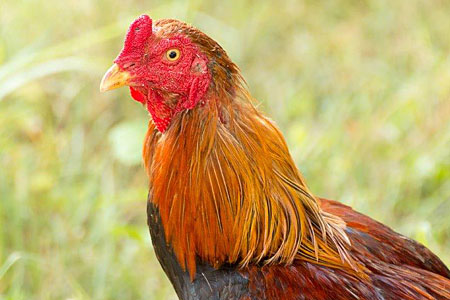
The Aseel chicken is an ancient game fowl from India. The name of this indigenous breed means trueborn or purebred.
Aseels have an upright stance, square shanks, and short legs set wide apart. Their ears are red, and they have a pea comb and minimal wattles. These slow-growing chickens have well developed muscles, although their short, hard, tight plumage makes them look much less heavy than they actually are.
Aseel hens lay some 40 or fewer small eggs per year with pale brown shells. They may not be great layers, but they are excellent broodies and fiercely protective mothers.
Aseel Varieties
Aseels were first exhibited in the United States at the 1887 Indiana State Fair. The American Poultry Association (APA) classifies them under All Other Standard Breeds (AOSB) in the Oriental group. The standard weights are 5½ pounds for roosters, 4 pounds for hens.
Aseels come in several color varieties, of which five are standard. Recognized by the APA in 1981 are black breasted red, dark, spangled, and white varieties. Wheaten was accepted in 1996.
Since 1996, Cackle Hatchery® Breeding Farms have selectively bred these three varieties:
Black Breasted Red Aseel Chicken — The BBR Aseel rooster has a gorgeous red saddle and a black breast. The lovely hen is brown with a golden orange neck.
Dark Aseel Chicken — The dark Aseel is solid glossy black, although some red may appear in the neck and back hackle feathers.
Wheaten Aseel Chicken — Wheaten Aseel roosters have stunning orange, red, and black feathers. The hens’ feathers are different shades of wheat color except for the tail, which is black.
Chickens with Attitude
Aseels are notorious for their aggressive behavior toward each other and toward other chickens. By the time they are 3 months old, the highly territorial males will engage in vicious fighting unless housed separately.
Even when young, Aseels spar with each other and with other chicks. And mature hens continue to fight among themselves. But despite their aggression toward each other and toward other breeds, Aseels typically show affection toward their keeper.
Because of their assertiveness, Aseels don’t take well to close confinement. But for the same reason they are excellent foragers.
Although this is not the best breed for the novice, Aseels make a unique and rewarding breed for the experienced chicken keeper.
And that’s today’s news from the Cackle Coop.
Gail Damerow has authored numerous books about poultry, including The Chicken Encyclopedia.

